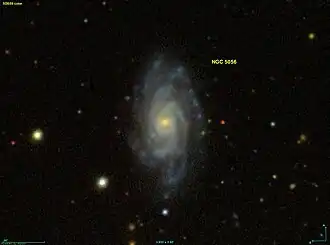NGC 5056
| NGC 5056 | |
|---|---|
 NGC 5056 imaged by SDSS | |
| Observation data (J2000 epoch) | |
| Constellation | Coma Berenices |
| Right ascension | 13h 16m 12.3527s[1] |
| Declination | +30° 57′ 01.239″[1] |
| Redshift | 0.018653±0.000005[1] |
| Heliocentric radial velocity | 5,592±1 km/s[1] |
| Distance | 208.31 ± 10.46 Mly (63.867 ± 3.207 Mpc)[1] |
| Group or cluster | [M98j] 192 |
| Apparent magnitude (V) | 13.7[1] |
| Characteristics | |
| Type | Scd[1] |
| Size | ~135,800 ly (41.65 kpc) (estimated)[1] |
| Apparent size (V) | 1.7′ × 1.0′[1] |
| Other designations | |
| IRAS 13138+3112, UGC 8337, MCG +05-31-166, PGC 46180, CGCG 160-173[1] | |
NGC 5056 is a spiral galaxy in the constellation of Coma Berenices. Its velocity with respect to the cosmic microwave background is 5,839±17 km/s, which corresponds to a Hubble distance of 280.9 ± 19.7 Mly (86.13 ± 6.03 Mpc).[1] However, 39 non-redshift measurements give a closer mean distance of 208.31 ± 10.46 Mly (63.867 ± 3.207 Mpc).[2] It was discovered by German-British astronomer William Herschel on 13 March 1785.[3][4]
NGC 5056 is listed as having an active galactic nucleus.[5]
According to Abraham Mahtessian, NGC 5056 and NGC 5065 form a pair of galaxies, known as [M98j] 192.[6]
Supernova
One supernova has been observed in NGC 5056:
- SN 2005au (Type II, mag. 15.8) was discovered by British amateur astronomer Ron Arbour on 19 March 2005.[7][8]
See also
References
- ^ a b c d e f g h i j k "Results for object NGC 5056". NASA/IPAC Extragalactic Database. NASA and Caltech. Retrieved 2 August 2025.
- ^ "Distance Results for NGC 5056". NASA/IPAC EXTRAGALACTIC DATABASE. NASA. Retrieved 2 August 2025.
- ^ Herschel, W. (1786). "Catalogue of One Thousand New Nebulae and Clusters of Stars" (PDF). Philosophical Transactions of the Royal Society of London. 76: 457–499. Bibcode:1786RSPT...76..457H. doi:10.1098/rstl.1786.0027.
- ^ Seligman, Courtney. "New General Catalogue Objects: NGC 5056". Celestial Atlas. Retrieved 2 August 2025.
- ^ "NGC 5056". SIMBAD. Centre de données astronomiques de Strasbourg. Retrieved 2 August 2025.
- ^ Mahtessian, A. P. (1998). "Groups of galaxies. III. Some empirical characteristics". Astrophysics. 41 (3): 308–321. Bibcode:1998Ap.....41..308M. doi:10.1007/BF03036100.
- ^ Arbour, R.; Briggs, D. (2005). "Supernovae 2005at and 2005au". International Astronomical Union Circular (8496): 3. Bibcode:2005IAUC.8496....3A.
- ^ "SN 2005au". Transient Name Server. IAU. Retrieved 2 August 2025.
External links
 Media related to NGC 5056 at Wikimedia Commons
Media related to NGC 5056 at Wikimedia Commons- NGC 5056 on WikiSky: DSS2, SDSS, GALEX, IRAS, Hydrogen α, X-Ray, Astrophoto, Sky Map, Articles and images